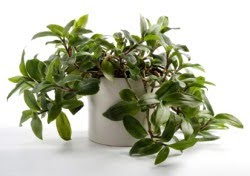
I asked my friends on Facebook the other day what sort of new house plants I should get. A few of mine died and I gave a few away so I wanted something new. Someone suggested a Wandering Jew Plant. I didn’t know what that was so I Googled it. Turned out I already had it! I got this plant from my aunt in the summer and just love it but I never knew what it was called so I didn’t really know the proper way to care for it. I did the usual and just watered it and put it in some indirect sun light and it seemed to do amazing. It doesn’t super well propagating and I’ve already given away 6 plants as gifts off of this plant and I’m working on the seventh.
Although it’s doing well I think it never hurts to know a little bit more about the plants you own. I want this plant to live a super long time and I’d really like to keep growing gift plants off of it so here are the tips and notes I found on caring for a Wandering Jew Plant.

How to Care for a Wandering Jew Plant
The Wandering Jew plant has leaves with white, silver and purple stripes supported by trailing stems. The stems grow to a foot long or more. Wandering Jew plants will often produce small lightly-colored blooms in spring and summer. Follow these steps to care for it.
Care Difficulty: Easy
Instructions
1) Plant Wandering Jew plants in hanging baskets. The branches will trail down the sides of the pot (I have mine on the top of my water cooler which gives the same effect).
2) Provide at least some direct sunlight every day. Wandering Jew plants do best in front of an east or south window. Lower light tends to reduce the color in the leaves, so placing in one of these windows, will provide a good amount of direct sun for the plant.
3) Give Wandering Jew plants warm temperatures and a good amount of humidity. If grown in a hanging basket, mist frequently and place a saucer underneath the plant. Fill the saucer with water every couple of weeks.
4) Take care to water the plant frequently. The potting mix should be kept moist.
5) Keep Wandering Jew plants in small pots. These plants generally don't need to be upgraded to anything larger than an 8-inch pot. Most times, you'll have to start over with a new plant before needing a pot larger than 8 inches.
6) Prune the ends of the stems frequently. This causes the stems to branch and the plant will become bushy. If not pruned, they will become long and spindly.

How to Propagate a Wandering Jew Plant
The ease of care and brightly colored leaves of a wandering Jew have made it one of the more popular houseplants. Because of its beauty, you may want to have more than one plant around. And with the ease of care, you may want to share it with friends. To accomplish both of these, you must propagate your wandering Jew.
Care Difficulty: Moderately Easy
Instructions
Things You'll Need:
Rooting hormone powder
1) Look for three to five healthy plant tips you can remove from the wandering Jew without detracting from its appearance. Wandering Jew plants regenerate growth where they are pruned in a few months.
2) Cut the portions of the plant off in sections about 3 inches long. The sections must be short because the energy of the plant needs to go to generating roots instead of keeping foliage alive.
3) Remove the leaves on the bottom of the plant and dip the stem in rooting hormone powder. The rooting hormone powder stimulates root development and prevents the stem from rotting.
4) Place all of the cuttings in one 3-inch pot filled with a peat moss and sand or a peat moss and perlite mixture. You'll want to place several in a pot because some cuttings may not survive and you need a bushy new plant. Also, be sure to point the tips in opposite directions around the pot so the stems won't all trail to one side. This creates a round plant.
5) Keep the Wandering Jew propagation in a warm spot where it can receive bright, but filtered, sunlight. Water the new plant when it dries out, but be careful not to over-water because wandering Jew propagation can be susceptible to rot.
6) Wait several months for roots to develop. New growth is a sure sign rooting has taken place. Once the wandering Jew cuttings have rooted, treat them as a mature plant. Propagate several small pots of wandering Jew and combine them into one large pot when they root to create a full hanging basket. (Source)

(with this I also find that you can just cut off pieces like they have noted and put them directly into a pot of moist soil. You can skip the rooting hormone powder which is what I do. I like things to grow naturally with as little interference from me as possible. I find with this plant propagating is super easy. Just keep that new plants soil moist, keep it in a sunny place and it roots no problem)

There were a few more articles that I read but they seemed to have conflicting information so I posted what I found the most accurate to my experience with this plant. Also I would suggest not watering it too often as I’m found it can cause the roots to rot. And I find that if this plant gets totally dry it’s not the end of the world, it’s a pretty resilient plant. Just water it and go on with life. It will be just find.

















































